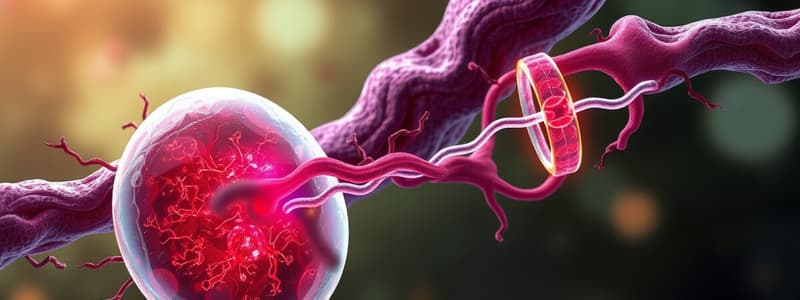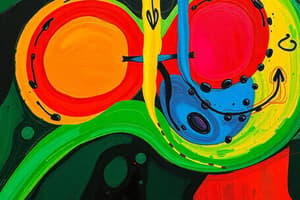Podcast
Questions and Answers
Which complex in the electron transport chain receives electrons from NADH?
Which complex in the electron transport chain receives electrons from NADH?
- Complex IV
- Complex I (correct)
- Complex III
- Complex II
What is the role of ubiquinone (Q) in the electron transport chain?
What is the role of ubiquinone (Q) in the electron transport chain?
- It facilitates proton pumping across the membrane.
- It generates ATP directly.
- It accepts electrons from Complex I or II. (correct)
- It reduces oxygen to water.
Which of the following is the final electron acceptor in the electron transport chain?
Which of the following is the final electron acceptor in the electron transport chain?
- Oxygen (correct)
- Cytochrome c
- NAD+
- FAD
What component receives electrons from FMN in Complex I?
What component receives electrons from FMN in Complex I?
Which complex involves cytochrome c in its electron transport process?
Which complex involves cytochrome c in its electron transport process?
What is produced as a result of the second phase of cellular respiration?
What is produced as a result of the second phase of cellular respiration?
How many ATP are produced from each NADH during this phase when translated by ETLP at the ETC?
How many ATP are produced from each NADH during this phase when translated by ETLP at the ETC?
What are the end products of the second phase of cellular respiration?
What are the end products of the second phase of cellular respiration?
What molecule is produced from isocitrate in the Krebs cycle?
What molecule is produced from isocitrate in the Krebs cycle?
Which compound is created before carbon dioxide is released from ketoglutarate?
Which compound is created before carbon dioxide is released from ketoglutarate?
What type of process occurs in the second phase of cellular respiration?
What type of process occurs in the second phase of cellular respiration?
What is the total number of pyruvic acid molecules generated in this phase?
What is the total number of pyruvic acid molecules generated in this phase?
What is the end product formed when succinyl CoA is converted in the Krebs cycle?
What is the end product formed when succinyl CoA is converted in the Krebs cycle?
What is the primary role of the intermembrane space in the mitochondrion?
What is the primary role of the intermembrane space in the mitochondrion?
What is reduced to FADH2 during the Krebs cycle?
What is reduced to FADH2 during the Krebs cycle?
Which molecule is converted to NAD+ in the inner mitochondrial membrane?
Which molecule is converted to NAD+ in the inner mitochondrial membrane?
Which intermediate is directly converted to malate in the Krebs cycle?
Which intermediate is directly converted to malate in the Krebs cycle?
Which complexes are part of the electron transport chain in the mitochondrial matrix?
Which complexes are part of the electron transport chain in the mitochondrial matrix?
What is needed to synthesize water at ATP synthetase?
What is needed to synthesize water at ATP synthetase?
What is produced alongside ATP when 3 ADP and 3 Pi are combined?
What is produced alongside ATP when 3 ADP and 3 Pi are combined?
What is the primary energy source that initiates cellular respiration?
What is the primary energy source that initiates cellular respiration?
Where does glycolysis occur in the cell?
Where does glycolysis occur in the cell?
What is produced as a waste product during cellular respiration?
What is produced as a waste product during cellular respiration?
What is the transition step that prepares pyruvate for the Krebs cycle?
What is the transition step that prepares pyruvate for the Krebs cycle?
How many ATP molecules are produced from one glucose molecule during cellular respiration?
How many ATP molecules are produced from one glucose molecule during cellular respiration?
What is generated from the decarboxylation of pyruvic acid in the Krebs cycle?
What is generated from the decarboxylation of pyruvic acid in the Krebs cycle?
Which of the following correctly describes the main function of the Krebs cycle?
Which of the following correctly describes the main function of the Krebs cycle?
What role do NADH and FADH2 play in cellular respiration?
What role do NADH and FADH2 play in cellular respiration?
What is the purpose of ATP synthase in the respiratory process?
What is the purpose of ATP synthase in the respiratory process?
What ultimately happens to the carbon atoms from glucose during cellular respiration?
What ultimately happens to the carbon atoms from glucose during cellular respiration?
What molecule is produced during the oxidation of pyruvate to acetyl CoA?
What molecule is produced during the oxidation of pyruvate to acetyl CoA?
Which of the following compounds begins the Krebs cycle?
Which of the following compounds begins the Krebs cycle?
Which of these molecules is formed from isocitrate in the Krebs cycle?
Which of these molecules is formed from isocitrate in the Krebs cycle?
Which substance is regenerated at the end of the Krebs cycle?
Which substance is regenerated at the end of the Krebs cycle?
In the Krebs cycle, which form of energy carrier is reduced during the oxidation of malate?
In the Krebs cycle, which form of energy carrier is reduced during the oxidation of malate?
Flashcards are hidden until you start studying
Study Notes
Second Phase of Cellular Respiration
- The second phase oxidizes intermediates, yielding 2 NADH and 2 pyruvic acids (pyruvates).
- Each NADH can be converted into 3 ATP via oxidative phosphorylation in the electron transport chain (ETC).
Electron Transport Chain Complexes
- The electron transport chain involves a series of protein complexes embedded in the inner mitochondrial membrane.
- Key components include:
- NADH: Supplies electrons to Complex I.
- FADH2: Supplies electrons to Complex II.
- FMN: Receives electrons from NADH in Complex I.
- Fe-S: Iron-sulfur clusters transferring electrons to Q.
- Q (Ubiquinone): Mobile electron carrier transferring electrons from Complexes I and II to Complex III.
- Cytochrome c: Transfers electrons from Complex III to Complex IV.
- Complex IV: Reduces oxygen to water, final electron acceptor.
Krebs Cycle (Citric Acid Cycle)
- Converts acetyl CoA into CO2, producing electron carriers (NADH, FADH2) and GTP/ATP.
- Key reactions:
- Isocitrate is converted to α-ketoglutarate with NAD+ forming NADH.
- α-Ketoglutarate is converted into succinyl CoA with CO2 release and NAD+ forming NADH.
- Succinyl CoA is converted to succinate, generating GTP (or ATP).
- Succinate is oxidized to fumarate, producing FADH2.
- Fumarate is converted to malate, then back to oxaloacetate, producing NADH.
Major Outcomes of the Krebs Cycle
- Generates 2 CO2 molecules and transfers electrons to electron carriers through redox reactions.
- Produces energy via substrate-level phosphorylation.
Summary of Cellular Respiration
- Three major stages:
- Glycolysis: Breakdown of glucose in the cytosol producing pyruvate.
- Krebs Cycle: Further breakdown of pyruvate in mitochondrial matrix, yielding NADH, FADH2, and ATP.
- Electron Transport Chain: High-energy electrons from NADH/FADH2 are passed down the chain, creating a chemiosmotic gradient to produce ATP.
- Total ATP yield from one glucose molecule ranges between 36 to 38.
Overview of ATP Synthesis
- ATP synthase utilizes the proton gradient to synthesize ATP from ADP and inorganic phosphate.
- Oxygen combines with electrons and hydrogen ions to form water, a byproduct of aerobic respiration.
Glucose Utilization
- Glucose (6-carbon) is broken down into two 3-carbon pyruvate molecules, eventually producing CO2 and ATP.
- CO2 is transported by blood to lungs for exhalation.
Importance of NADH and FADH2
- Vital electron carriers generated in glycolysis and the Krebs cycle; essential for ATP production in the ETC.
Mitochondrial Structure
- The mitochondrion comprises the intermembrane space, inner mitochondrial membrane, matrix with enzymes for Krebs cycle, and ATP synthetase for ATP production.
Studying That Suits You
Use AI to generate personalized quizzes and flashcards to suit your learning preferences.




